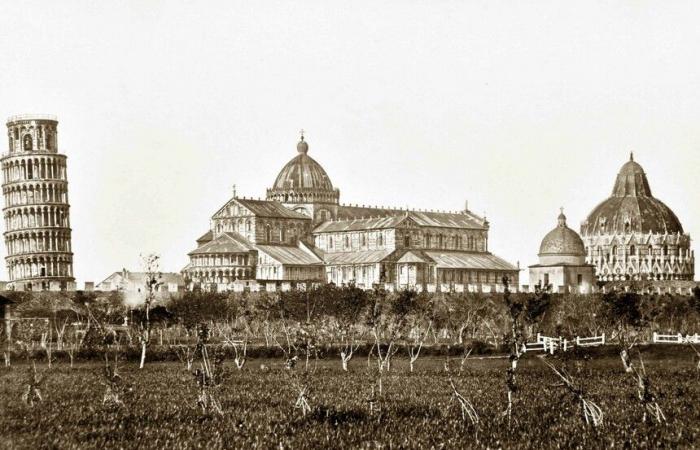58 meters high and almost 20 in diameter for a stainless object of desire. Of course, when, on August 9, 1173, they laid the first of the 32,400 blocks of marble that make up the most famous Tower in the world, no one imagined they were building an icon instead of the bell tower of a cathedral already built and functioning. Indeed, after a few years, as soon as they realized that the ground was giving way under its foundations, they left it there in the middle of the meadow without much ado. Not even the architect who had designed it wanted to recognize it as ‘his daughter’ and refused to sign that unfinished construction so as not to leave his name to posterity to be covered in shame.
Thus, if all the other monuments of what popular affection has renamed ‘Piazza dei Miracoli’ have a recognized author (Bruschetto had founded the Cathedral in 1063, Deotesalvi had laid the first stone of the Baptistery in 1152 and Giovanni di Simone will build the Camposanto starting from 1278), that Tower which was born twisted has remained fatherless to this day. But nothing is hidden from history and some excavations at the base of the bell tower have brought to light a fragmented epigraph in which the name of Bonanno Pisano can be read.
Initially thought to be a sepulchral inscription, it was later discovered that, being written backwards, it was a matrix for a bronze plate. Most likely the plate with which Bonanno, an expert bronze worker, wanted to sign the bell tower. But thinking that his project had failed, he closed the construction site and abandoned the matrix among the debris.
It took a century for the Pisans to decide to resume construction and then another hundred years to complete that leaning tower by adding the bell tower. At the time they thought that she was not perfect, because she was born and remained inclined, despite numerous measures, the victim of a ‘dark evil’ that they could not explain. But the cathedral square was finally finished and they were satisfied with this. They could never have thought that precisely that ‘defect’ would make the monument and the city famous throughout the world, even more than the feats they wanted to celebrate.
Today, the fragment of that epigraph that does justice to the author of a bell tower that amazed the world not only for its leaning, but also for its grace, originality and elegance, is on display in the same square, in the premises of the Opera della Primaziale, where, at the end of a period of events and celebrations for the 850th anniversary of the foundation of the Leaning Bell Tower, its many lives are told, those that have seen him as a protagonist over the centuries.
“We wanted to show a Tower in the mirror, that is, reflected in the countless surfaces that have replicated its image, as clues and signs that reveal a way not only of seeing, but also of thinking about the Tower,” explains the curator of the exhibition, Stefano Renzoni.
In fact it is strange because what is the bell tower of the Cathedral built to contain the bells with which to mark the hours and pastoral events, is still today mistaken by tourists for a tower in its own right, not at all linked to what is around it. Rather than its concrete function, we often think instead of the needs of defending the territory, almost as if it were a watchtower for the protection of the city, from which to identify potential enemies from afar.
It was with the advent of tourism, which began at the time of the Grand Tour, that the Bell Tower began to lose its religious connotation and was transformed simply into the leaning towera tourist attraction that arouses curiosity due to its astonishing slope.
«Until the 18th century it is almost impossible to trace isolated images of the Bell Tower, which was correctly depicted next to the Cathedral», says the curator of the exhibition.
«From the end of the 18th century, however, our Bell Tower was insistently depicted in isolation, separated from the Cathedral, becoming a Tower, appreciated for its static risk. It was a transformation in the representation that was itself the reflection of a perceptive revolution».
Here she is, then, the great ‘lady’ afflicted by an incurable disease on a journey that begins with her bells and their rules, established in an ancient manuscript, with which the passage of time in the city and the rhythms of daily life were marked. Path that ends with the 30,000 Lego bricks with which the Tower was rebuilt, complete with lighting.
In the middle, a rich iconographic collection of paintings, engravings and etchings that span the centuries, from the sixteenth to the twentieth century, in which the Campanile appears to us from various angles thanks to which it is also possible to reconstruct the environment and the skyline of the city before its modern configuration. Keith Haring and René Magritte also celebrated it in their paintings while other contemporary artists, from Gianni Lucchesi to Francesco Barbieri and Giuseppe Bartolini have continued to reinterpret it according to less usual pictorial languages, demonstrating the universality of a monument that has now become a symbol.
Moreover, the Opera della Primaziale, the religious and secular organization that has owned all the monuments in the Piazza del Duomo since their foundation, has been inundated for years with projects of fantasy and affection that have arrived from all over the world with the intention of saving the Bell Tower from a fate that is at the very least uncertain.
There were those who wanted to support it with flying helicopters, those who wanted to anchor it, those who, instead, supported it against a building, perhaps a hotel with who knows how many stars. It’s funny to see how some of these proposals turned out to be naively similar to those actually practiced between 1990 and 2000 to heal the sick elderly woman and restore her full health at least for another 200 years. Let’s be clear, the Tower leans as always, but it has been straightened by about 45 centimeters and its inclination is now firm and stabilized while the consolidation of its stones protects it from structural collapse.
Long live the king, then, in spite of those slightly mischievous tourists who every day have their picture taken in the act of knocking it down. They won’t succeed anyway and she, the Leaning Tower or the Bell Tower of the Cathedral, as we prefer to call it, has now also received another birthday gift. To the delight of philatelists, Poste Italiane has in fact put into circulation 300,015 copies of a stamp all its own, with the attached cancellation of the first day of issue, June 14, 2024. The wish is obvious: another 850 of these days. And certainly even more.






